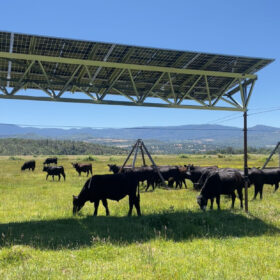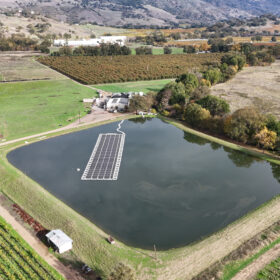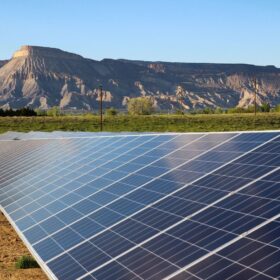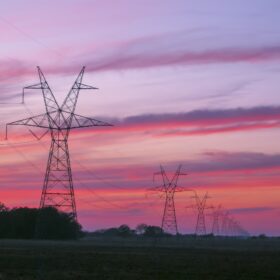Top News
Solar-plus-storage VPPs must be ‘indistinguishable’ from peakers to win over grid operators, says EnergyHub

RUTE SunTracker opening cattle grazing land to solar power

California winery powers 100% of its operations with floating solar array
SunRise Arabia Clean Energy Conference 2026
Join the 3rd SunRise Arabia Clean Energy Conference on April 22, 2026, in Riyadh to explore how solar PV and energy storage are powering the Kingdom’s growing digital economy — including data centers. Secure your spot at the early-bird rate.
Battery Business & Development Forum 2026
Connect with Europe’s energy storage leaders at the Battery Business & Development Forum 2026 in Frankfurt (March 31–April 1) and gain insights into evolving business models, financing strategies, and market trends
Out now - pv magazine Global Winter Edition
The new pv magazine Global edition is out now!
Available in print and digital – get your copy today!

CleanCapital, Soltage, Pivot Energy close major financing deals

Texas BESS: GridStor inks tolling agreement for 350 MWh project, Sunrun teams up with NRG Energy for low-cost home storage
After a five-month freeze, BLM finally advances a solar project
NineDot Energy enrolls 300 MW of community energy storage in New York
Ford axes Lightning EV Truck, pivots to $2 billion grid-scale storage manufacturing
Press Releases
Solesca Launches ARGUS 1.0 AI Auto-Obstruction Detection Feature
Stewart Glass: The First U.S. Solar Glass Facility
Arevon’s 124 Megawatt Big Muddy Solar Project Advances Construction in Illinois
How AI is Revolutionizing Solar Contracting: Understanding AMECO’s Approach
Installations
Featured
U.S. Q3 energy storage deployment grows 31% year-over-year
Pennsylvania township approves permit for solar project on 2,000 acres of toxic coal mine land
Rush Township Supervisors in Centre County, Pennsylvania approved permits for Black Moshannon Solar, a 265 MW project.
What to know about ERCOT’s new RTC+B program
Under the real-time co-optimization structure, batteries will be recognized as both generators and loads.
BayWa r.e. secures $416 million for San Diego solar and storage project
The company secured financing for the Jacumba Valley Ranch, which includes 90 MW of solar and 70 MW / 280 MWh battery energy storage.
Growth in Q3 2025 community solar limited to three states
Tracking by the Institute for Local Self-Reliance shows limited growth of community solar, only three states grew by 1% or more with New York in the lead with 55% growth.
Solar and storage represent 91% of clean power additions in Q3 2025
Of the 11.7 GW of clean power capacity added in Q3 2025, utility-scale solar and battery energy storage accounted for 91% of the total, said a report from the American Clean Power Association.
Manufacturing
Featured
Waaree secures 288 MW hail-resilient module order for Texas utility-scale solar projects
ESS–EV battery supply chain bifurcates as U.S. manufacturers pivot toward storage
While the long-term impacts of the elimination of the United States’ federal electric vehicle tax credit remain unknown, it’s clear that battery manufacturers in the country are starting to shift their approach toward grid-scale storage rather than EV batteries.
Endurans Solar launches transparent backsheet for utility-scale bifacial modules
The U.S. based manufacturer has completed certification of its latest adhesive-free, fluorine-free backsheet.
ES Foundry prepares to accelerate production of FEOC-compliant PERC solar cells
The South Carolina-based solar cell manufacturer plans to triple its output of domestic solar cells by the end of 2026.
Nextpower opens monitoring center and doubles steel output at Memphis plant
Nextpower, formerly Nextracker, announced it has opened a remote monitoring center for its solar tracker systems in Nashville, Tennessee and also expanded its Memphis steel manufacturing capacity.
Canadian Solar consolidates U.S. manufacturing under parent, including solar and storage
By moving US manufacturing assets out from under its China-listed firm, while aiming to be a developer, a module manufacturer, and a battery producer, without the China-owned scrutiny.
Markets & Policy
Featured
RFQ alert: City of Austin seeks quotations for 111 solar installations
RFP Alert: CPS Energy seeks 500 MW of Texas battery storage
CPS Energy, which acts as sole provider of electricity in San Antonio, Texas, plans to have 1,000 MW of operational or contracted storage capacity following the completion of its latest request for proposal for an additional 500 MW of additional storage capacity.
Wood Mackenzie predicts 2-year decline in global solar inverter demand
Wood Mackenzie’s latest analysis expects market uncertainty in China, Europe and the U.S. to cause two consecutive years of contraction in the global solar inverter market, forecasting a fall to 577 GWac this year and 523 GWac in 2026.
Sustainable home upgrade finance platform GoodLeap announces $523 million securitization
GoodLeap, which provides financing for home solar, energy storage, and more, announced a securitization sponsored by Bank of America.
Amazon leads funding round for U.S. silicon solid-state battery maker
Blue Current, which has a pilot production line in California, will use funding from an $80 million financing round led by Amazon to advance commercialization of its silicon solid-state battery technology for stationary storage and mobility applications in the United States.
Experts predict the top trends in U.S. residential solar for 2026
As the residential solar industry looks ahead to 2026, experts predict a bumpy ride with some fundamental changes to business operations, financing, and the long-term value of home solar.
Technology
Featured
New framework quantifies solar land use with unprecedented detail
Require a gas unit to add 90 MW of batteries to renew its air permit, group says
When a New Jersey gas unit’s air pollution permit is up for renewal, state law allows the public to recommend ways for the unit to reduce its emissions, such as adding batteries. That’s what one group has done.
Texas electric utility co-op taps networked residential batteries for outage protection
The residential battery program, which deploys Base Power’s 11.4 kW/25 kWh battery systems, is designed to provide affordable, whole-home backup for members of Farmers Electric Cooperative while also delivering grid-balancing services to the wider region.
U.S. space solar startup proves wireless power system works in motion
Overview Energy has proven its solar power beaming satellite system works in motion, which it claims is a world first for high-power wireless energy transmission. The company is targeting megawatt transmission from space in 2030.
Research finds solar can support bird, bat activities
A pair of research studies led by the Argonne National Laboratory have demonstrated how “ecovoltaic” installations in the midwestern United States are home to more bird and bat activities than nearby fields used for agriculture.
The role of robotics in boosting U.S. solar recycling capacity
Solar recycler OnePlanet will draw on vision-guided robots and automation to scale their River City facility and recover more, purer valuable materials from spent panels.



